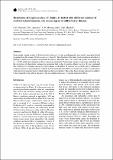| dc.contributor.author | CO Omondi, PO Ayiecho, Agnes W Mwang'ombe, H Hindorf | |
| dc.date.accessioned | 2020-08-10T10:16:25Z | |
| dc.date.available | 2020-08-10T10:16:25Z | |
| dc.date.issued | 2001-08-01 | |
| dc.identifier.uri | https://repository.maseno.ac.ke/handle/123456789/1928 | |
| dc.description.abstract | Seven single conidia isolates of Colletotrichum kahawae varying in pathogenicity were used to inoculate hybrid progenies from 66 crosses ofCoffea arabica cv. Ruiru 11. The objective of this study was to investigate the effect of pathogen variation on resistance of the Ruiru 11 cultivar. The main effects of crosses and isolates were significant (p ≤0.05) while their interaction effects were non-significant. Partitioning variance components indicated that the proportion of phenotypic variance for resistance that is due to genetic effects was low. It was concluded that variation for resistance among hybrid progenies of the Ruiru 11 cultivar was probably due to differences in aggressiveness of the pathogen as reflected by the significant main effects of crosses and isolates in combination with other environmental factors which influence disease epidemics. The coffee berry disease pathogen is unlikely to have adapted to the cultivar because of the non-significant crosses × isolates interaction effects. | en_US |
| dc.publisher | Springer Netherlands | en_US |
| dc.title | Resistance of Coffea arabica cv. Ruiru 11 tested with different isolates of Colletotrichum kahawae, the causal agent of coffee berry disease | en_US |
| dc.type | Article | en_US |

